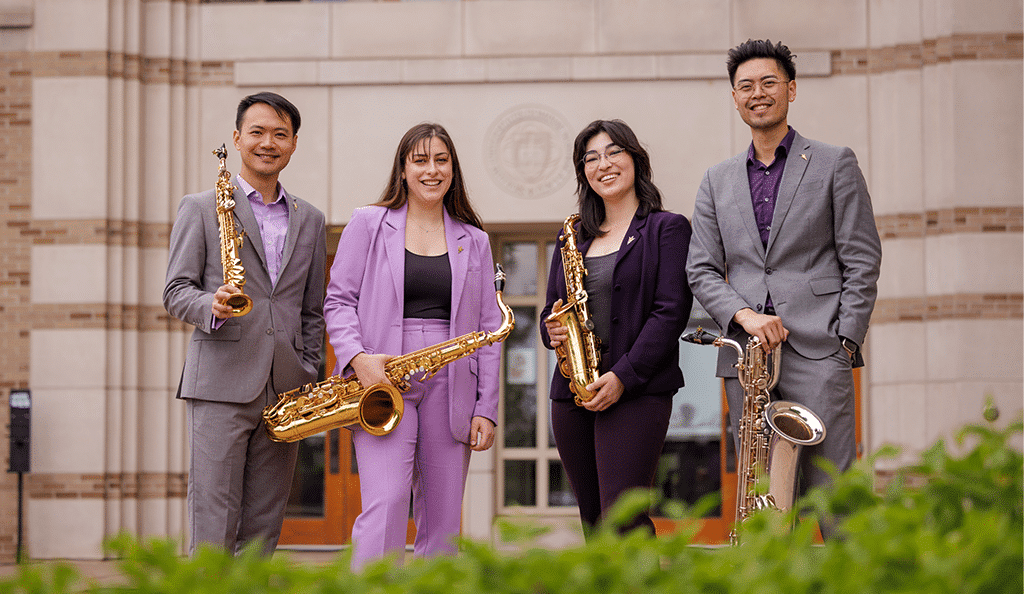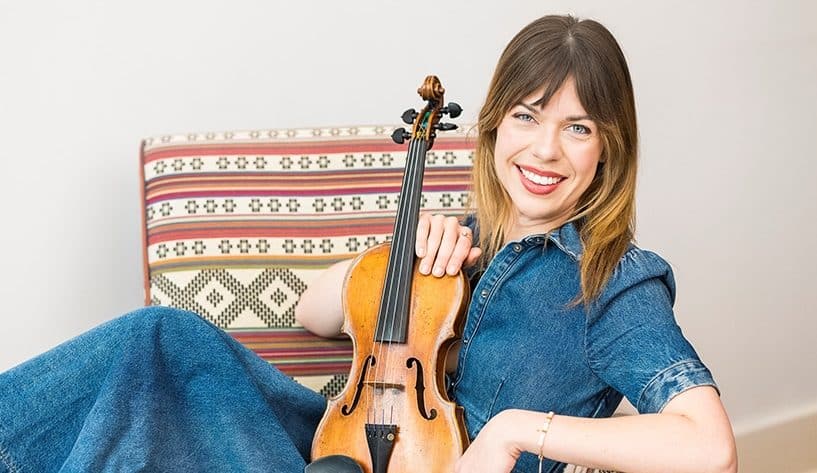Meet the Grantees: Pathos Trio
Following their Lincoln Center debut, Ensemble Forward grant recipients Pathos Trio talks about their commissioning journey

With a signature sound that’s at once dark and heavy yet distinctly classical, Pathos Trio is making a name for themselves, thanks to their steadfast dedication to commissioning new works and breaking down the barriers of contemporary classical music. And in the five years since forming in late 2018, they’ve racked up accolades to show for it: The ensemble placed first in the 2023 American Prize for Virtual Performance for Chamber Music; was a semi-finalist for Concert Artist Guild’s 2022 Victor Elmaleh Virtual Competition; and has received multiple grants from not only CMA, but also New Music USA, Foundation for Contemporary Arts, Johnstone Fund for New Music, Amphion Foundation, Alice Ditson Fund, and New York State Council for the Arts, amongst others.
So what’s the secret to successful commissioning? Following their Lincoln Center debut last month, CMA staffer Ben Schonhorn caught up with Pathos’s managing director and percussionist Felix Reyes to learn more.
How and when did Pathos Trio come into existence?
Pathos was originally a percussion duo between myself and Marcelina Suchocka. We met through social media in the Fall 2017, and we quickly became best friends. After forming our duo, we started reaching out to composers we wanted to commission, and that’s where Alan Hankers (our original third member) came into play. He wrote our first piece and became the pianist and third member of the group. And once we recorded his piece, the rest was history.
You’ve received an Ensemble Forward grant twice from CMA, working with two distinct coaches: Eric Cha-Beach and Jeff Milarsky. What unique perspectives did each coach offer?
Working with Eric and Jeff were amazing. They both brought so much to the table, and it helped us improve our tiro’s communication in both rehearsal and performance settings. Eric is a percussionist and a performer himself, so he really understands the nuances of what Marcelina and I experience in having to not only know how to play multiple instruments (sometimes even at the same time), but also how to practice the coordination that goes into all of that. On the other hand, Jeff is a conductor and an artistic director, and he taught us how to better communicate and think about the music we’re playing.
I was listening to your second album, Polarity, and it’s unlike anything I’ve heard before. How has Pathos’s sound and aesthetic developed?
In terms of our “sound,” we’re always looking to combine elements from other non-classical genres of music—such as (but not limited to) electronic music, alternative rock, grunge, progressive/heavy/black metal, and minimalist music—into the pieces we commission. For our first album, When Dark Sounds Collide, which consisted of our first batch of commissions, we approached contemporary classical chamber music composers (including Alyssa Weinberg, Alison Yun-Fei Jiang, Alan Hankers, and Finola Merivale) to write pieces with the idea of bridging these vastly different worlds. A really illuminating piece for us on our first album was “Fiction of Light,” by Evan Chapman, because that piece had the tone and aesthetic that we were looking for in future commissioning. Chapman’s piece set the stage for what was to come in our second album, Polarity, because all the music on this album feels like a progression of “Fiction of Light.” In a lot of ways, Polarity was a rebranding of Pathos Trio.
What was the process of commissioning six new works for Polarity, and how do those commissions evolve when touring?
We are super involved in the commissioning process; we like to be very collaborative with each composer. For the pieces on Polarity, we spent a year and a half working with each composer, holding countless workshops to iron out the music and instrumentation, finding what worked or not to create commissions we all felt proud of. For us, collaborating with composers on new music is what we live for. We want to make sure that at the end of the collaboration, the final product is something we are all extremely happy with and something that we will want to perform for years to come.
Fine-tuning elements of Polarity’s new pieces—realizing what works and does not—happens on the spot in live performance settings. While we become more and more comfortable with the music itself, we also get more comfortable in dealing with the electronics, as each piece on this album has some aspect of electronics involved, whether it’s using audio playback or electronic instruments, or needing to make sure our sessions in Ableton/Logic X were working accordingly whenever using MIDI instruments.

We’re corresponding a few days after the final concert of your fifth season, which took place at Lincoln Center. Congratulations! How was the process of preparing for such a monumental concert and how are you feeling post-concert?
Putting this concert together was particularly stressful. We’d been preparing since the beginning of March, and there was a lot to do, from individual invitations/solicitations to digital promotions and figuring out venue logistics. Preparation also meant practicing all our music to make sure we were as tight as possible, including practicing the logistics of the electronics to ensure everything was running smoothly and creating foolproof back-up plans just in case something stopped working during the performance. It was incredibly stressful. But because of all this prep work, the concert went amazingly. It was a nearly sold-out show with a very receptive audience that loved the music and program. We are feeling quite proud and we are so excited about our future.
As a multi-time CMA grantee, what advice do you have for ensembles applying for CMA grants?
Make sure you’re honest with your storytelling and showing your ensemble in the best light. Be clear in explaining what your group is about and what makes you stand out from other chamber ensembles out there. We’re always unapologetic in talking about how our group’s intention is combining non-classical genres with classical chamber music techniques and aesthetics to create music that’s unique, challenging to audiences, and bridges both worlds of classical and non-classical genres.
To end this interview, I have to ask a staple question of mine: If you were to describe Pathos Trio as a sandwich, what would it be and why?
Since we see ourselves as an amalgamation of various genres of music, I would say that we’d be a burger with a kick to it, because that’s the type of reaction we are always striving to get from our audiences. Something along the lines of the Metal Massacre, which is a metal-influenced burger you can get at a place called Kuma’s Corner in Chicago—it comes with a 10-ounce homemade patty; habanero aioli; jalapeños; cherry peppers; two slices of Pepper Jack; ghost pepper seasoning; and lettuce, tomato, and onion on a pretzel bun.
Check out Pathos Trio in mid-to-late August for a week-long residency at Avaloch Farm Music Institute in New Hampshire, and follow them on Instagram @Pathostrio to stay up-to-date with their performances as well as news of their forthcoming third album.



